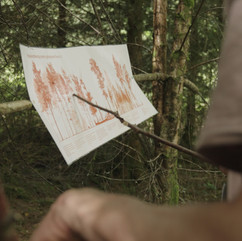On the 28th of July 2024, a group of around 25 eager participants gathered at Tony Mac's Public House to embark on an enlightening field trip to a plantation beside the Ancient Native Woodland at Caher, Lough Graney.
Organized by the Centre for Environmental Living & Training (CELT) and supported by the Department of Agriculture, Food and the Marine (DAFM) through the Forestry Promotion Funding, this event aimed to shed light on the innovative practices of Continuous Cover Forestry (CCF).
Journey into Sustainable Forestry
The field trip began with a short introduction to the day's agenda and a briefing on the significance of the site we were about to visit. Our destination was a conifer plantation in the early stages of transformation from a monoculture to a mixed broadleaf-conifer forest, with aspirations of eventually becoming a native woodland. This transformation is being meticulously managed through selective logging methods, also known as Continuous Cover, Close-to-nature, or Irregular forestry.
As we ventured into the plantation, the guide explained how this approach involves periodic thinnings to open up the canopy, thereby enhancing tree quality, biodiversity, and other ecosystem services over time without resorting to clear-felling. The plantation, predominantly consisting of Sitka spruce with some larch monocultures, presented a unique opportunity to observe different transformation strategies tailored to each type of monoculture.
Topics and Discussions
Throughout the walk, several key topics were covered, sparking engaging discussions among participants:
Principles of Continuous Cover Forestry: Understanding the basic tenets of CCF and its benefits over conventional forestry methods.
Challenges in Transforming Even-aged Plantations: Addressing issues such as wind stability and deer management.
Site-specific Implementation: Exploring various methods of CCF implementation based on specific site conditions and owners' objectives.
Interventions in Forestry Management: Discussing different thinning regimes, enrichment planting, and deer protection measures.
Management of Broadleaf Plantations: A closer look at the management practices for oak forests and the integration of Scotch pine.
Tree Marking and High Pruning Demonstrations: Practical demonstrations that provided hands-on learning experiences.
Conventional vs. Alternative Logging Methods: Comparing traditional harvesting techniques with low-impact alternatives.
Commercial Viability and Government Support: Insights into the financial aspects and available government grants for sustainable forestry practices.
Experiencing Ancient Native Woodland
A highlight of the trip was the visit to the neighbouring oak forest, where Scotch pine was used to cover some broadleaf management aspects. Walking through the Ancient Native Woodland, with oaks over 200 years old, was a truly awe-inspiring experience. The grandeur of these ancient trees served as a powerful reminder of the importance of preserving and responsibly managing our natural heritage.
Conclusion
The CELT field trip to Caher, Lough Graney was a resounding success, leaving participants with a deeper understanding of sustainable forestry practices and the practicalities of implementing Continuous Cover Forestry. The hands-on demonstrations and in-depth discussions provided valuable insights, making the event both educational and inspiring.
As we concluded the trip and made our way back to Tony Mac's Public House, there was a palpable sense of accomplishment and a renewed commitment to promoting sustainable forestry practices. Events like these are crucial in fostering a community of informed and engaged individuals dedicated to the stewardship of our forests.
For those interested in future events and learning opportunities, keep an eye on the CELT website for updates. Remember to bring suitable footwear and clothing for your next adventure into the heart of sustainable forestry!
We wish to extend thanks to all who attended, Julius the guide and forest owner, and to the Department of Agriculture, Food and the Marine (DAFM) for their funding under the Forestry Promotion Funding and to our core funders the Irish Environmental Network.


















Comments